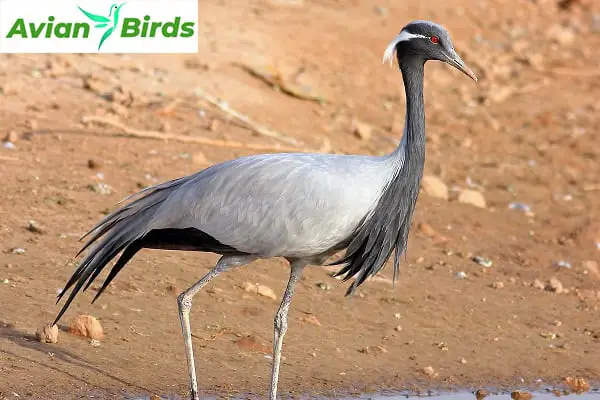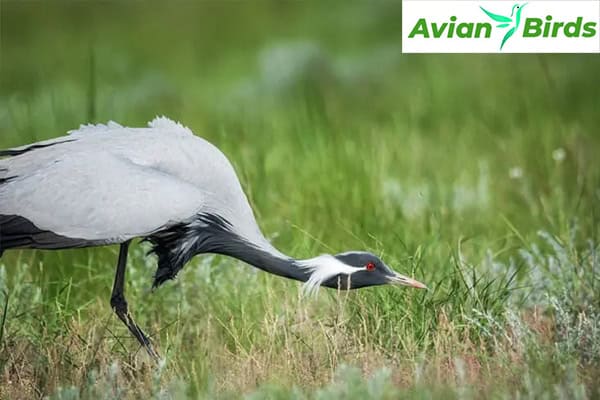Discover the Graceful Demoiselle Crane | A Guide
Did you know the Demoiselle Crane is among the world’s most elegant birds? It can grow up to 3.5 feet tall. This bird is famous for its beauty and elegant moves. In this guide, we’ll explore what makes the Demoiselle Crane a favorite among bird lovers.
The Demoiselle Crane comes from central Asia, Africa, and parts of Europe. It amazes people with its unique behaviors. We’ll look into its key traits and history. You’ll learn why this crane is so special in the bird world.
Fun Facts:
Scientific Name: Anthropoides virgo
Weight: 2 – 2.7 kg
Length: 85 – 95 cm
Wingspan: 155 – 180 cm
Lifespan: Approximately 14 years
Diet: Primarily plant-based, including seeds and vegetation, with occasional consumption of small invertebrates such as insects
Habitat: This species is infrequently found in the eastern Paleartic during summer. Its preferred habitats include steppes, prairies, rocky areas, grasslands, and woodlands, ideally with access to streams, shallow lakes, or wetlands. They can also inhabit desert regions if water sources are present.
Threats: The primary threat to this species is habitat loss. In Afghanistan and Pakistan, they are also hunted for sport, which further exacerbates their vulnerability.
Introduction to the Demoiselle Crane
The Demoiselle Crane, known as Anthropoides virgo, is a bird that captures the hearts of many. It’s known for its grace and has unique traits that make it stand out. Learning about its features and history can deepen your respect for this beautiful bird.
Characteristics and Distinctive Features
This crane is the smallest of its kind, with long legs and a slender neck. It has bluish-gray feathers and a black neck with white ear tufts. Its bright reddish eyes are another clear sign of its identity. It weighs between 2 and 2.7 kg and has a wingspan of 155 to 180 cm. These cranes live in open areas, like fields and steppes, near water.

Habitat and Range
The Demoiselle Crane is adaptable to many environments, which helps it survive. Knowing where it lives and moves can deepen your understanding of its life and importance in nature.
Preferred Habitats and Locations
Demoiselle Cranes live in open areas like steppe, savannah, and grasslands. They are found in central Asia, southern Europe, and northern Africa. These birds need places with water, like shallow lakes and streams, to survive.
They nest in dry areas but can also live in deserts if there’s water nearby. Their range stretches from the northern Black Sea to China and Mongolia. Sadly, they are rare in Spain and the Balkans due to habitat loss. Protecting their homes is key to keeping their populations healthy.
Migration Patterns and Seasonal Movements
Their migration is a sight to see, with unique flight patterns. They move to warmer places in Africa and India for the winter. Most come from central Asia for this journey.
These cranes fly very high, up to 16,000 to 26,000 feet. Their migration shows off their teamwork and communication in flight. These moves are vital for their survival, as they face many dangers along the way.
Diet and Feeding Habits
The Demoiselle Crane eats a wide range of foods, making it an omnivorous bird. It mainly eats plants but also small animals during some seasons. This shows how it can change its diet to fit the time of year.

Main Food Sources
The Demoiselle Crane eats different foods in different seasons. Its main foods are:
- Seeds
- Leaves
- Fruit
- Insects and small invertebrates during the breeding season
This mix of foods helps the crane stay healthy, especially when it’s raising its young.
Feeding Strategies and Seasonal Variations
The Demoiselle Crane changes how it finds food based on the season. In the fall and winter, it looks for grains and crops in fields. In spring and summer, it eats the new green shoots of crops.
This way, the crane gets the right food all year, which is important for its health. This is especially true when it’s breeding and taking care of its young.
| Season | Main Food Sources | Feeding Strategies |
|---|---|---|
| Autumn | Grains, seeds | Foraging in fields |
| Winter | Grains, crops | Opportunistic feeding in agricultural landscapes |
| Spring | Green shoots, insects | Focused foraging around nesting sites |
| Summer | Tender plants, small invertebrates | Active foraging, reliance on rich vegetation |
Breeding and Parenting of the Demoiselle Crane
The Demoiselle Crane’s breeding habits are quite interesting. They have unique ways of nesting and a clear reproductive cycle. From April to June, they build simple nests near water. These nests are shallow and lined with grasses and plants.
The female lays 2 to 4 eggs, which take about 28 to 36 days to hatch. Both parents guard the nest and keep the eggs safe.
Related Video:
Nesting Behavior and Reproductive Cycle
The Demoiselle Crane’s nesting behavior shows their strong family bond. The male and female choose a nesting site together. They take turns incubating the eggs, protecting them from threats.
This teamwork is key to the survival of their young.
Chick Development and Parental Care
After hatching, the chicks are covered in down and can leave the nest quickly. They grow fast, getting feathers and learning to fly in 50 to 90 days. Both parents feed and teach their young important survival skills.
This care helps the chicks and strengthens the bond between the parents.
Check Our Previous Articles:
| Black-Headed Duck |
| Red-Breasted Goose |
| Eurasian Blue Tit: Colorful European Songbird |
| Finches in Illinois |
| Hawks in Ohio |
Wrapping Up…
The Demoiselle Crane is a stunning bird that shows us the importance of nature’s balance. By learning about their home, food, and how they live, we can appreciate these elegant cranes more. It’s crucial to understand why we need to protect them as their homes and ways of life are under threat.
Watching birds like the Demoiselle Crane helps us connect with nature. Seeing these beautiful birds can make us want to help protect them and their homes. Every time we see them, we can support efforts to save their habitats and other birds too.







